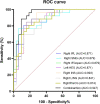Aberrant brain intra- and internetwork functional connectivity in children with Prader-Willi syndrome
- PMID: 38001311
- PMCID: PMC10761436
- DOI: 10.1007/s00234-023-03259-x
Aberrant brain intra- and internetwork functional connectivity in children with Prader-Willi syndrome
Abstract
Purpose: Prader-Willi syndrome (PWS) suffers from brain functional reorganization and developmental delays during childhood, but the underlying neurodevelopmental mechanism is unclear. This paper aims to investigate the intra- and internetwork functional connectivity (FC) changes, and their relationships with developmental delays in PWS children.
Methods: Resting-state functional magnetic resonance imaging datasets of PWS children and healthy controls (HCs) were acquired. Independent component analysis was used to acquire core resting-state networks (RSNs). The intra- and internetwork FC patterns were then investigated.
Results: In terms of intranetwork FC, children with PWS had lower FC in the dorsal attention network, the auditory network, the medial visual network (VN) and the sensorimotor network (SMN) than HCs (FWE-corrected, p < 0.05). In terms of internetwork FC, PWS children had decreased FC between the following pairs of regions: posterior default mode network (DMN) and anterior DMN; posterior DMN and SMN; SMN and posterior VN and salience network and medial VN (FDR-corrected, p < 0.05). Partial correlation analyses revealed that the intranetwork FC patterns were positively correlated with developmental quotients in PWS children, while the internetwork FC patterns were completely opposite (p < 0.05). Intranetwork FC patterns showed an area under the receiver operating characteristic curve of 0.947, with a sensitivity of 96.15% and a specificity of 81.25% for differentiating between PWS and HCs.
Conclusion: Impaired intra- and internetwork FC patterns in PWS children are associated with developmental delays, which may result from neural pathway dysfunctions. Intranetwork FC reorganization patterns can discriminate PWS children from HCs.
Registration number on the chinese clinical trail registry: ChiCTR2100046551.
Keywords: Functional connectivity; Independent component analysis; Magnetic resonance imaging; Prader-Willi syndrome.
© 2023. The Author(s).
Conflict of interest statement
The authors declare that the research was conducted in the absence of any commercial or financial relationships that could be construed as a potential conflict of interest.
Figures





Similar articles
-
Aberrant brain structural-functional coupling and structural/functional network topology explain developmental delays in pediatric Prader-Willi syndrome.Eur Child Adolesc Psychiatry. 2025 Jul;34(7):2155-2167. doi: 10.1007/s00787-024-02631-3. Epub 2024 Dec 20. Eur Child Adolesc Psychiatry. 2025. PMID: 39704789 Free PMC article.
-
Altered functional organization within and between resting-state networks in chronic subcortical infarction.J Cereb Blood Flow Metab. 2014 Apr;34(4):597-605. doi: 10.1038/jcbfm.2013.238. Epub 2014 Jan 8. J Cereb Blood Flow Metab. 2014. PMID: 24398939 Free PMC article.
-
Intranetwork and Internetwork Functional Connectivity Changes Related to Speech Disorders in Adults With Cleft Lip and Palate.Eur J Neurosci. 2025 Apr;61(7):e70077. doi: 10.1111/ejn.70077. Eur J Neurosci. 2025. PMID: 40219708
-
Dysregulation within the salience network and default mode network in hyperthyroid patients: a follow-up resting-state functional MRI study.Brain Imaging Behav. 2020 Feb;14(1):30-41. doi: 10.1007/s11682-018-9961-6. Brain Imaging Behav. 2020. PMID: 30259292 Review.
-
Opposite effects of dopamine and serotonin on resting-state networks: review and implications for psychiatric disorders.Mol Psychiatry. 2020 Jan;25(1):82-93. doi: 10.1038/s41380-019-0406-4. Epub 2019 Apr 5. Mol Psychiatry. 2020. PMID: 30953003 Review.
Cited by
-
Aberrant brain structural-functional coupling and structural/functional network topology explain developmental delays in pediatric Prader-Willi syndrome.Eur Child Adolesc Psychiatry. 2025 Jul;34(7):2155-2167. doi: 10.1007/s00787-024-02631-3. Epub 2024 Dec 20. Eur Child Adolesc Psychiatry. 2025. PMID: 39704789 Free PMC article.
References
-
- Prader A, Labhart A, Willi H. Ein syndrom von adipositas kleinwuchs, kryptorchismus and oligophrenie nach myotonicartigem zustand in neugeborenalter. Schweiz Med Wochenschr. 1956;86:1260–1261.
-
- Cassidy SB, Forsythe M, Heeger S, Nicholls RD, Schork N, Benn P, Schwartz S. Comparison of phenotype between patients with Prader-Willi syndrome due to deletion 15q and uniparental disomy 15. Am J Med Genet. 1997;68:433–440. doi: 10.1002/(SICI)1096-8628(19970211)68:4<433::AID-AJMG12>3.0.CO;2-T. - DOI - PubMed
MeSH terms
Grants and funding
LinkOut - more resources
Full Text Sources
Medical
Miscellaneous

